photos by Rachel Adler
This is Galapagos. She is a turtle.
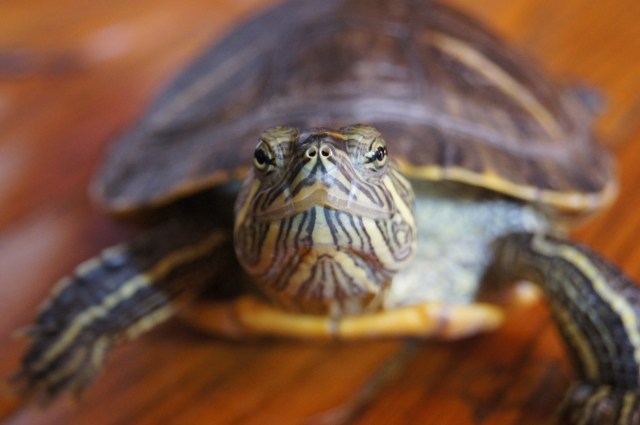
Sometimes, I feel like I will never be able to live my very best queer life because I developed an allergy to cats in my late teens. Yes, I’ve heard there are hypoallergenic options, but however much money it takes to obtain a hypoallergenic cat isn’t really in my financial picture at the moment. Plus, I don’t really have anything in my life planned past a few months from now, so making the long-term commitment of pet-having isn’t really feasible for me.
But when my friend asked me if I could care for her turtle for a year while she lived abroad, my answer was an immediate yes. A year with a turtle, it seemed to me, was a perfectly acceptable short-term alternative to a cat – mostly because it wouldn’t make me want to scratch my eyes out of my face, but also because my general impression was that turtles are chill and low-maintenance while also being willing to react with affectionate enthusiasm towards their human captors.
A week later, Galapagos the Turtle was residing in a large tank by my living room. She is a red-eared slider, about 8 inches long. She spends her days swimming, basking under her sun lamp, and sometimes wandering the apartment while supervised.
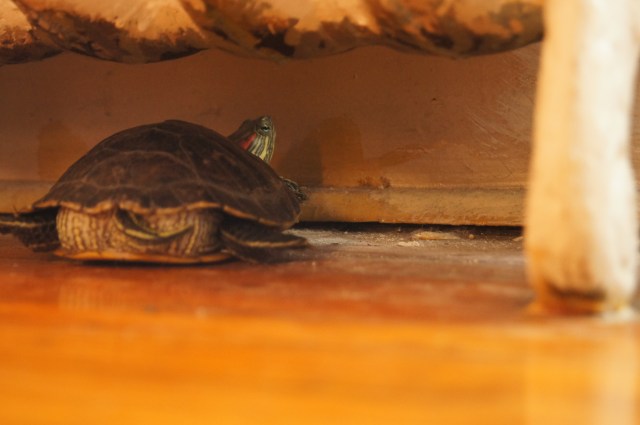
And what I’ve found is that, while she isn’t a cat, there are more similarities than you might expect. Here are the ways my turtle is and isn’t fulfilling all my dreams of cat-ownership:
1. The turtle is not fuzzy
I’m just making sure everyone is on the same page: the turtle is not fuzzy, and she will not cuddle with you.
She is animated enough to make it very gratifying to project whatever kind of desire for anthropomorphized companionship you might have onto her, just as long as you are okay with that anthropomorphized companion being a withholding introverted weirdo, unless she thinks you have food. Usually, when I approach my turtle, she runs as far from me as she can. Except when she’s out of her tank and I’m trying to clean it using the bucket she usually eats in. Then, she tries to bite my toes.
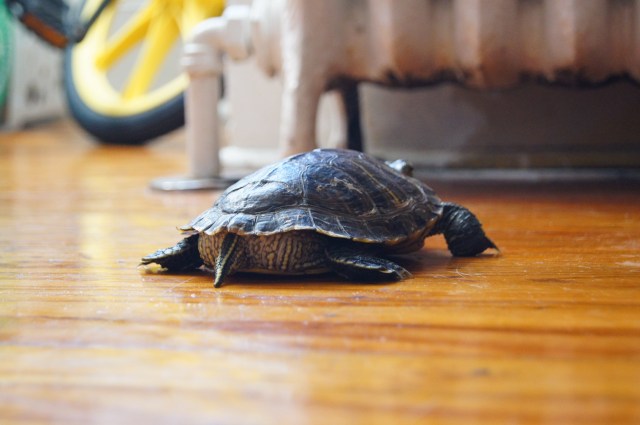
2. She would probably eat me if she were bigger.
Have we all read the study about how cats would eat you if they were bigger? I’m pretty sure the same is true of the turtle, who tries really hard to be ferocious, but fails pretty much every time because she’s just too damn small. If I hold my finger up to the glass of her tank, she’ll snap at it, but she can’t bite me. If I take her out of her tank to let her roam the living room or put her in the bucket to eat, she’ll squirm around or try to bite at me, but I can easily avoid her toothless jaw just by holding her from the tail-end of her shell. Her claws are pretty sharp, but I don’t anticipate them breaking skin the way cats’ claws can.
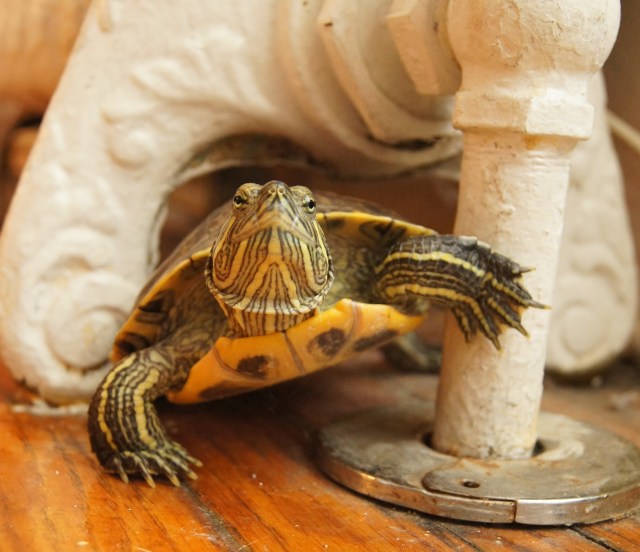
3. The turtle eats fish. And bugs.
Like a cat, G’s diet consists mostly of pellets made of some sort of dried fish substance. I take her out of the tank in a bucket and dump a handful of pellets in with her and she scrambles around the bucket eating them. When she’s done, I plop her back in the tank, dump the gross pellet-y water down the toilet, and put a bucket of fresh warm water back in the tank. She gets really excited about this.
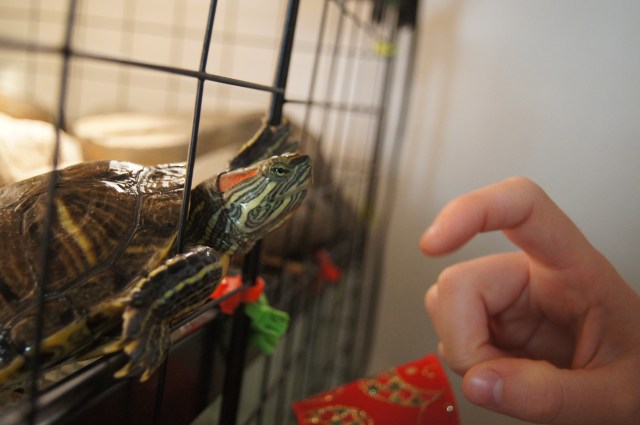
But SOMETIMES, to keep her diet (and life) varied and interesting, she gets to eat live food. This can be in the form of fish or worms or crickets. I’m not trying to set a bunch of crickets loose in my living room; worms are fine, but not very exciting. Feeding her fish, on the other hand, is a show worthy of a Friday night. Literally, I’ve had friends over on a Friday night just to witness the turtle eating fish. You have to go buy them from Petco for like 17 cents each, and then when the turtle sees the bag she knows and starts swimming like crazy against the side of the tank.
Then you dump them in and the turtle proceeds to spend the next significant period of time zooming around the tank chasing them. The thing is that both the turtle and the fish are really fast. Sometimes the fish get out of the way just in time and the turtle does a face-plant into the side of the tank (her shell absorbs most of the impact; don’t worry about the turtle’s head). But when the turtle does catch a fish, she swallows it whole. It can feel a little sadistic to watch in fascination, but it’s really not much more graphic than watching Ms. Pac Man gobble Inky or Blinky. It’s also a lot more fun than when a cat catches “live food,” because usually when a cat catches “live food” it means she’s caught a mouse or a chipmunk or the family goldfish, and she plays with it while it fights for its life, kills it with satisfaction, and then shows it off.
4. Turtle tanks are more annoying to clean than litter boxes
In a similar fashion to cats, you have to clean up the turtle’s poop, except instead of scooping it out of a box where some magic combination of chemical dirt has made the poop dry and clumped, the turtle poops in the water it lives in, and you have to scoop it out by submerging a net and probably a good part of your forearm into the turtle water. Then you have to get rid of the waste, and sometimes you have to empty out all the water from the tank and fill it up again. Let me tell you, managing that process while living in an apartment building is a real party. Any water from the tank has to be dumped, bucket by bucket, into the toilet, and then refilled, bucket by bucket, from the sink. Hauling buckets of water around an apartment is not my favorite way to spend two hours. Litter boxes are, quite frankly, just easier.
For us, one thing that makes it a lot easier to keep things clean is that the turtle’s rocks for basking under her heat lamp are totally separate from the water in her tank. She can climb between the two areas, but the rocks never get wet.
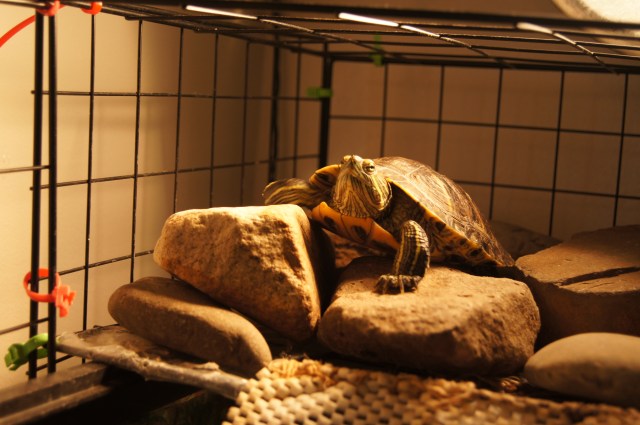
5. Turtles can carry salmonella
It’s part of their “natural flora.” And chances are, unless you let your turtle co-mingle with raw chicken or egg shells, your turtle probably doesn’t have salmonella, but it’s still pretty unadvisable to cuddle your face into your turtle’s shell, or kiss it on the nose.
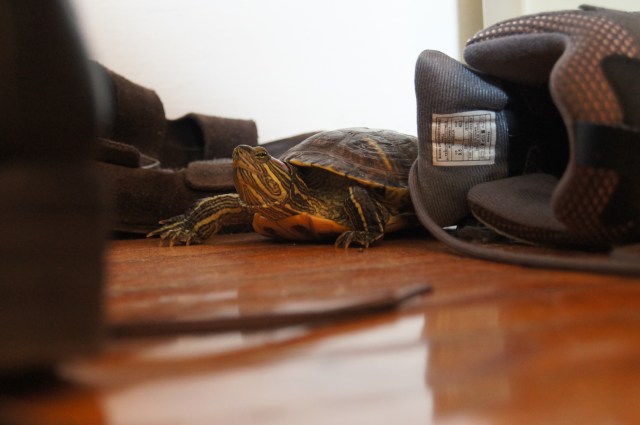
6. Bonding over turtles can help humans deepen their own relationships
So I live with one of my best friends from college and her boyfriend. I do like this boyfriend person a lot, but he’s even more introverted than I am, so we don’t talk a whole lot. But once the turtle entered our lives, we began a new chapter in our relationship. He LOVES THE TURTLE, and so now she has become our main topic of conversation. Sometimes he even sends me snapchats of her. We have an ongoing project of trying to discern if the turtle recognizes us and/or her food and/or the color of the canister that holds her food.
7. It would be shitty to release my turtle to the wild if I got bored with her
Hello, it’s me, up here on my soapbox. This is the part of the article where I give you a little public service announcement about invasive species, which red eared-sliders are. They are native to the southern United States and northern Mexico, but when they’re introduced in other areas, they outcompete the other turtle populations – they eat like monsters, dominate habitats and transmit disease. Unfortunately, they’re now prevalent all over the world because they either escape or are released from captivity. Some countries and states have banned them, so if this article has convinced you they’d make a great pet, look into that first. Also, if you’re considering getting a turtle, make sure you can commit! Red-eared sliders can live for as long as forty years! There are ways to ethically unhand a turtle if you can’t care for it anymore, so don’t just dump it in a pond if you can’t take care of it anymore. Give it to someone who wants it. Similarly, if you would like a turtle as a pet, see if you can adopt one from someone who can’t care for it anymore.
Do you have a turtle or other small reptile? Is it like a cat or not like a cat? How does your turtle feel about shoes?








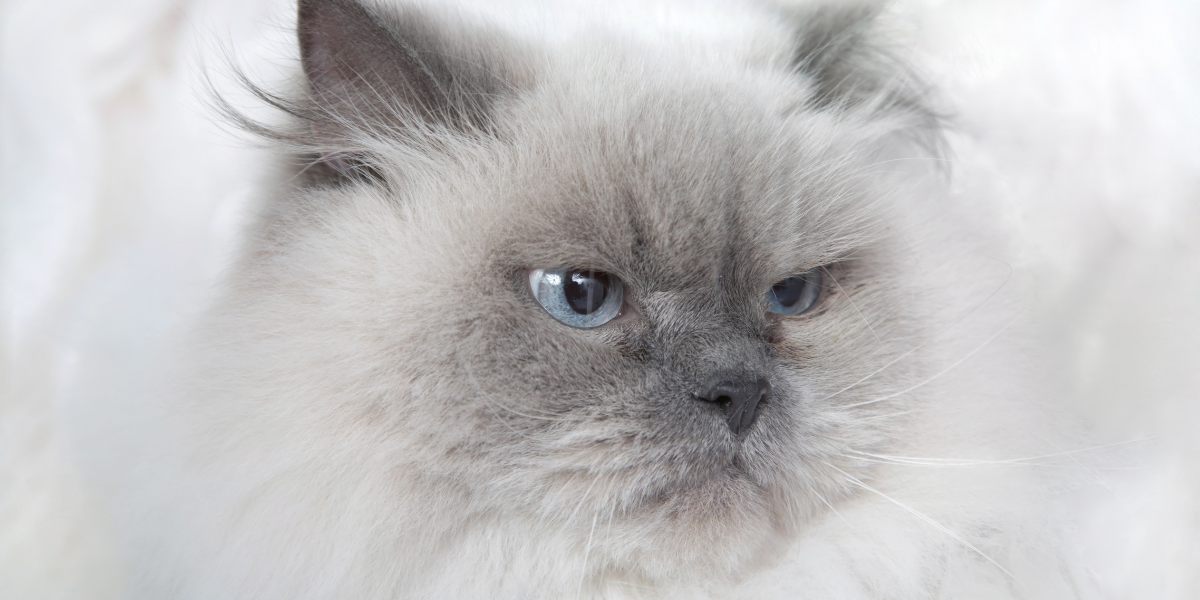
Comments
so basically, turtles are shy amphibian cats
yes, precisely.
shy *reptile* cats. ;-)
I have always wanted a turtle since i was little :). After reading this, i kind of want to get one now ;)
Saaaame! :)
i loved a good many things about this article. i am sorry you feel like you will never live your best queer life. may your queer life be filled with other creatures that make you happy but do not make you claw your eyes out.
i am very lucky to report that my queer life is, indeed, filled with creatures that do not claw my eyes out but do make me very happy!
I had a roommate who let her turtle wander the yard with a kind of leash duct taped to its shell and the leash detached and it wandered off and that’s the end of THAT story.
Bottom line: if you want to let the turtle in the yard, buy it a balloon.
oh no!!! mixing duct tape with turtles only sounds like bad news!
i do really want to try the balloon thing, though.
This is so cute and interesting!
Marry meeeeeeeeeeee.
okay! Galapagos can be the ring bearer and the flower grrrl.
We can duct tape the ring to her shell.
?
Also for anyone interested in turtles, they need about 10 gallons minimum per square inch of shell…per turtle. I learned this after I bought two turtles on vacation in S.C. when I was 16. Parents were thrilled.
Turtles are fucking awesome though, I had to get rid of mine when I went to college and I miss them so much. Theyre weird little aliens, its fun
can’t handle this I’m done it’s too much I really lost it at the video
You and your relationship with G are very cute. Thanks for the public service announcement at the end. Your wildlife biologist fans are very proud indeed.
This is definitely one of the cutest articles i’ve ever read in my life
Also worth mentioning: DO NOT BUY TURTLES OFF THE STREET (cities like NY, for example).
These turtles are bred in similar circumstances to puppy mills, only worse, they are not raised well, and so are often unhealthy, and if by some miracle they survive, most people don’t realize that they can grow to a foot in length or more, need large tanks (10 gallons to 1 inch of shell length is a good basic rule), need very heavy duty filter pumps, specialized diets, UV and heat lamps, and a great deal of care. Oh, and to boot, they’re great climbers, so they escape very easily, and are decidedly not safe with cats and dogs, who often attack and badly mutilate the turtles (yes, even if they are “friends”).
I had a ball python and she was sort of similar. Cleaning a snake cage is much easier though, because they poop once a week. But yeah, didn’t care much for humans, noodled around when you let her out and mostly enjoyed sleeping on her heated rock.
Snake poo is so bad! So here’s the thing, I love snakes I think they’re awesome, but I will never ever hold one again after my friends corn snake pooped on me when I was 15… It was so, so, extremely bad. So I will never own a snake, cleaning liquid snake poop off my school uniform in a public bathroom put me off for life.
Agreed on the snake poop – I work at a nature center, where I’ve been pooped on by at least a dozen different species and cleaned the habitats of several dozen more. Snake poop is by far the stinkiest/grossest!
I love this article, can there be a column on pets? I have a rat that I’m obsessed with who is currently very adorably licking my hand while I type this and I would like more queer girls talking about animals in my life
I used to have rats! I miss them tremendously. They were a gift from a friend who decided I needed to have rats, so she bought me two wee girl ratties & I named them Olivia & Viola, like in Twelfth Night. They were the best. Their favorite treat was dehydrated banana chips.
(This article has been helpful in telling me I would not like dealing with the turtle water situation, and so that is Not My Pet. I’m crazy allergic to cats, & my tiny apartment plus the fact that I’m rarely home means my life can’t support a dog. More pet articles, please!)
I have access to 60+ species on a regular basis… I would LOVE to write about them here!
Yay other turtle owners! I agree re your like a cat points completely. Aloof yet responsive to food is an accurate description…much like most cats. Our yellow bellied slider goes for walks in the bathtub only, because the dog would eat them if we let them off around the house :( We have a monster external tank filter which eliminates the poop net situation…however I’m down with the idea of removal of the turtle for feeding…we’d need a big bucket, our turtle is about a foot long when all limbs and head are fully extended. They’re currently being extremely grumpy and possibly trying to hibernate which means I have to keep encouraging them into the water to feed. Silly turtle.
Pets for people with cat allergies! I’m so here for that!
This is quite the timely article since I’ve been considering getting a pet turtle. They may not be the cuddliest of creatures but they are just so cute.
This makes me think I experience cats differently to others. I find most cats super cuddly and friendly and happy to see me, this is despite being totally grossed out by cat food and therefore having never fed a cat in my life (that’s my brother job). I love cats but i don’t know if i would if they ignored me.
This turtle is the cutest, second only to you, Maddie!
My roommate in college had a red-eared slider that she bought on the internet. It came in a styrofoam clam shell like it was a take-out burger. Probably not the most reputable breeder…but anyway. This makes me wonder what Dresden is doing 10 years later and if he got really big like Galapagos. He was the size of a quarter when she got him.
I accidentally started reading the part about turtle poop while my mom was reading aloud a recipe for how to make ricotta cheese, but otherwise I love this!
When I was a child I wasn’t allowed pets (I know!) but somehow I was able to convince my mother to allow me and to get a turtle. I named him Corgan. He was awesome. I was absolutely convinced that he recognized me, and his food container. He would wander around my bedroom sometimes, and I loved him.
Then I went to college, and my parents failed to clean the tank or do much more than give him food often enough to keep him alive. He got really sick, and I actually came home in the middle of a semester to take care of him…
ANYWAYS… Turtles are awesome. ?❤️?❤️?❤️?
Can you tell us more about the baby’s house situation?! my turtle is having house envy, I think he needs a major renovation. Any tips??
so I didn’t construct the tank configuration (the friend who I’m taking care of the turtle for did) – but it’s a 36x18x12 tank, and then there’s an enclosed part that sits on top where the turtle can bask, and that enclosure is made out of wire shelves like these, held together with zip ties, including a ramp from the water up to the platform that’s made of one of those shelves with a rubber mat over it, so the turtle can climb.
i hope that at least gives you some ideas! those shelf components work really well.
To make cleaning the tank easier, get a Python No Spill Clean and Fill system. They’re expensive, but worth every penny. There are also a few other cheaper brands out there. Check the Foster and Smith site.
It attaches to your sink and you run the hose to the tank. Turn on the water, and it siphons the tank. Turn the knob on the assembly at the sink and it fills the tank. You can take the gravel washer piece off to drain more water (I can usually get it down to 3″ with it on). But I can change the water in my 55 gallon aquarium (and I do 75% changes every week) in about 10-15 minutes without having to lug buckets back and forth. It’s a beautiful thing.
I used to have tortoises and they were the best. Like grumpy old people, who REALLY REALLY REALLY LOVE BABY CORN.
It seems odd that you say your turtle will not cuddle with you. I have a year and a half old box turtle, and she loves to cuddle. She climmbs up my swear shirt and takes a nap on my chest while I watch cricket, or rugby. I guess maybe like all animals it just comes down to the individual. I have to agree with you on the live feeding part though, Luna not being aquatic doesn’t chase fish but she does take live worms out of my hands and will chase crickets and suck around her enclosure. She has also discovered that if she hisses at my dog she moves, so she likes to chase Hayley around the loungeroom.